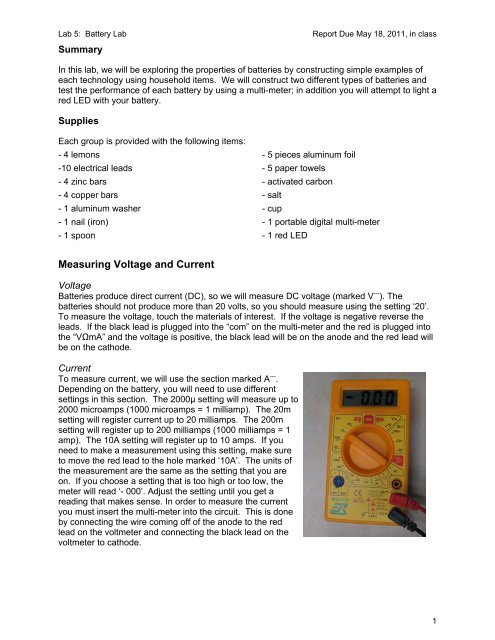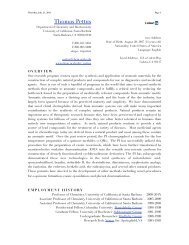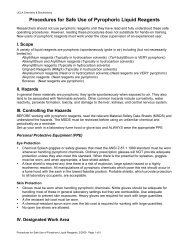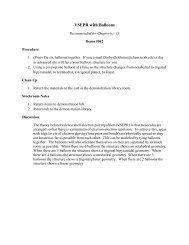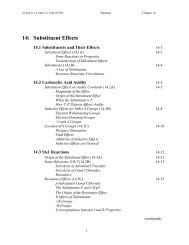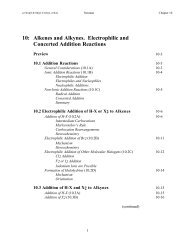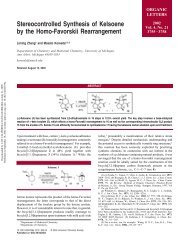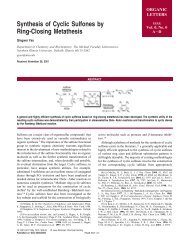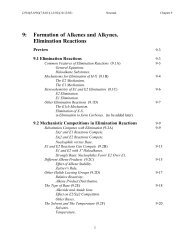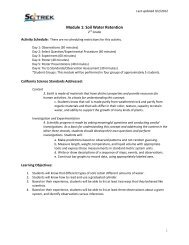Measuring Voltage and Current
Measuring Voltage and Current
Measuring Voltage and Current
Create successful ePaper yourself
Turn your PDF publications into a flip-book with our unique Google optimized e-Paper software.
Lab 5: Battery Lab Report Due May 18, 2011, in class<br />
Summary<br />
In this lab, we will be exploring the properties of batteries by constructing simple examples of<br />
each technology using household items. We will construct two different types of batteries <strong>and</strong><br />
test the performance of each battery by using a multi-meter; in addition you will attempt to light a<br />
red LED with your battery.<br />
Supplies<br />
Each group is provided with the following items:<br />
- 4 lemons - 5 pieces aluminum foil<br />
-10 electrical leads - 5 paper towels<br />
- 4 zinc bars - activated carbon<br />
- 4 copper bars - salt<br />
- 1 aluminum washer - cup<br />
- 1 nail (iron) - 1 portable digital multi-meter<br />
- 1 spoon - 1 red LED<br />
<strong>Measuring</strong> <strong>Voltage</strong> <strong>and</strong> <strong>Current</strong><br />
<strong>Voltage</strong><br />
Batteries produce direct current (DC), so we will measure DC voltage (marked V --- ). The<br />
batteries should not produce more than 20 volts, so you should measure using the setting ‘20’.<br />
To measure the voltage, touch the materials of interest. If the voltage is negative reverse the<br />
leads. If the black lead is plugged into the “com” on the multi-meter <strong>and</strong> the red is plugged into<br />
the “VΩmA” <strong>and</strong> the voltage is positive, the black lead will be on the anode <strong>and</strong> the red lead will<br />
be on the cathode.<br />
<strong>Current</strong><br />
To measure current, we will use the section marked A --- .<br />
Depending on the battery, you will need to use different<br />
settings in this section. The 2000μ setting will measure up to<br />
2000 microamps (1000 microamps = 1 milliamp). The 20m<br />
setting will register current up to 20 milliamps. The 200m<br />
setting will register up to 200 milliamps (1000 milliamps = 1<br />
amp). The 10A setting will register up to 10 amps. If you<br />
need to make a measurement using this setting, make sure<br />
to move the red lead to the hole marked ‘10A’. The units of<br />
the measurement are the same as the setting that you are<br />
on. If you choose a setting that is too high or too low, the<br />
meter will read ‘- 000’. Adjust the setting until you get a<br />
reading that makes sense. In order to measure the current<br />
you must insert the multi-meter into the circuit. This is done<br />
by connecting the wire coming off of the anode to the red<br />
lead on the voltmeter <strong>and</strong> connecting the black lead on the<br />
voltmeter to cathode.<br />
1
Lab 5: Battery Lab Report Due May 18, 2011, in class<br />
Procedure<br />
I. The Lemon Battery<br />
A lemon battery is made using a lemon <strong>and</strong> two metallic electrodes. The juice in the lemon is<br />
the electrolyte in the battery. When the electrodes are connected by a wire, a chemical reaction<br />
occurs at each electrode. Electrons are produced by the reaction at the negative electrode, or<br />
anode, <strong>and</strong> flow through the wire to the positive electrode, or cathode. This flow of electrons<br />
per time is the current through the wire.<br />
To make a lemon battery:<br />
First, soften the lemon by rolling it around on a table while pressing down with your palm.<br />
Next, select two electrodes. There are four electrode choices: copper, zinc, aluminum (washer),<br />
<strong>and</strong> iron (nail). If the electrode material appears corroded, use the s<strong>and</strong>paper to gently remove<br />
the corrosion.<br />
Insert the electrodes through the lemon skin, the electrodes should be close together but should<br />
not touch. Attach an electric lead to each of the electrodes. If the voltage is a negative number<br />
switch the leads. When you get a positive voltage the red lead will be on the cathode <strong>and</strong> the<br />
black lead will be on the anode.<br />
1. With one lemon, try different combinations of materials for the electrodes. Measure the<br />
current <strong>and</strong> voltage for each pair you try, <strong>and</strong> then record the results in the chart below. Make<br />
sure that you correctly identify which material is the cathode <strong>and</strong> which material is the anode.<br />
Also make sure to include the correct units for each measurement.<br />
Cathode Anode <strong>Voltage</strong> <strong>Current</strong><br />
2
Lab 5: Battery Lab Report Due May 18, 2011, in class<br />
2. Two lemon battery cells can be connected to form a bigger battery.<br />
a) Using the zinc <strong>and</strong> the copper try to hook 2 lemons up in different ways to get two distinct<br />
batteries (different voltages <strong>and</strong> currents).<br />
Draw a picture of the two batteries below:<br />
Battery 1:<br />
Battery 2:<br />
CURRENT:_____________<br />
VOLTAGE:_____________<br />
CURRENT:_____________<br />
VOLTAGE:_____________<br />
b) Show you picture to Darby or Stacy <strong>and</strong> they will give you the definition of parallel <strong>and</strong><br />
series<br />
Series:______________________________________________________________________<br />
____________________________________________________________________________<br />
Battery _________ is wired in series.<br />
Parallel:_____________________________________________________________________<br />
____________________________________________________________________________<br />
Battery ___________ is wired in parallel.<br />
3
Lab 5: Battery Lab Report Due May 18, 2011, in class<br />
c. Using the same type (same anode <strong>and</strong> cathode material as part 2a), create a battery by<br />
connecting the lemons in series. When you add each lemon (up to 3 lemons) measure the<br />
voltage <strong>and</strong> current produced in the resulting battery <strong>and</strong> show the results.<br />
<strong>Voltage</strong><br />
1.2<br />
1<br />
0.8<br />
0.6<br />
0.4<br />
0.2<br />
0<br />
1 2 3<br />
Lemons<br />
1.2<br />
1<br />
0.8<br />
0.6<br />
0.4<br />
0.2<br />
0<br />
1.2<br />
1<br />
0.8<br />
0.6<br />
0.4<br />
0.2<br />
0<br />
1 2 3<br />
Lemons<br />
Make sure that you label the vertical axes with the appropriate scale <strong>and</strong> units.<br />
What is the relationship between the number of lemons <strong>and</strong> the voltage/current?<br />
______________________________________________________________________<br />
______________________________________________________________________<br />
______________________________________________________________________<br />
d. Using the same type (same anode <strong>and</strong> cathode material as part 2a), create a battery by<br />
connecting the lemons in parallel. When you add each lemon, up to 3 lemons, measure the<br />
voltage <strong>and</strong> current produced in the resulting battery <strong>and</strong> show the results.<br />
<strong>Voltage</strong><br />
1.2<br />
1<br />
0.8<br />
0.6<br />
0.4<br />
0.2<br />
0<br />
1 2 3<br />
Lemons<br />
1.2<br />
1<br />
0.8<br />
0.6<br />
0.4<br />
0.2<br />
0<br />
<strong>Current</strong><br />
1.2<br />
1<br />
0.8<br />
0.6<br />
0.4<br />
0.2<br />
0<br />
1 2 3<br />
Lemons<br />
Make sure that you label the vertical axes with the appropriate scale <strong>and</strong> units.<br />
What is the relationship between the number of lemons <strong>and</strong> the voltage/current?<br />
______________________________________________________________________<br />
______________________________________________________________________<br />
______________________________________________________________________<br />
______________________________________________________________________<br />
<strong>Current</strong><br />
1.2<br />
1<br />
0.8<br />
0.6<br />
0.4<br />
0.2<br />
0<br />
1.2<br />
1<br />
0.8<br />
0.6<br />
0.4<br />
0.2<br />
0<br />
4
Lab 5: Battery Lab Report Due May 18, 2011, in class<br />
3. Show your results from parts 2c <strong>and</strong> 2d to Darby or Stacy <strong>and</strong> they will give you the<br />
answers to the next two questions.<br />
a) In an ideal situation what happens to the voltage <strong>and</strong> the current when batteries are wired in<br />
series?<br />
______________________________________________________________________<br />
______________________________________________________________________<br />
______________________________________________________________________<br />
______________________________________________________________________<br />
b) In an ideal situation what happens to the voltage <strong>and</strong> the current when batteries are wired in<br />
parallel?<br />
______________________________________________________________________<br />
______________________________________________________________________<br />
______________________________________________________________________<br />
______________________________________________________________________<br />
4. What is the ideal current <strong>and</strong> voltage for the following system? A single battery has a voltage<br />
of 1.5 V <strong>and</strong> 1.0 A.<br />
VOLTAGE: _________________ CURRENT: ____________________<br />
What is the ideal current <strong>and</strong> voltage for the following system? A single battery has a voltage of<br />
1.5 V <strong>and</strong> 1.0 A.<br />
VOLTAGE: _________________ CURRENT: ____________________<br />
5
Lab 5: Battery Lab Report Due May 18, 2011, in class<br />
SKIP THIS PART UNTIL THE END<br />
5. Draw a picture of a zinc/copper battery (made from a combination of zinc/copper batteries)<br />
that will produce 0.70 mA <strong>and</strong> 1.6 volts, based on your data. (Note: Having the correctly drawn<br />
picture is worth ¾ of the points for this problem). Construct the battery <strong>and</strong> have Darby or Stacy<br />
verify your findings. When drawling the picture use the voltage <strong>and</strong> current from the chart on<br />
page two to determine the ideal voltage <strong>and</strong> current of battery<br />
a) What is the voltage <strong>and</strong> current of a single zinc/copper battery? (from table on page 2)<br />
VOLTAGE: _________________ CURRENT: ____________________<br />
b) What is the ideal voltage <strong>and</strong> current of your new battery?<br />
VOLTAGE: _________________ CURRENT: ____________________<br />
c) What is the actual voltage <strong>and</strong> current of your new battery?<br />
VOLTAGE: _________________ CURRENT: ____________________<br />
d) Does your battery light the red LED? Hook the long end of the LED to the copper <strong>and</strong> the<br />
short end of the LED to the zinc. ___________________________<br />
6
Lab 5: Battery Lab Report Due May 18, 2011, in class<br />
II. The Aluminum-Air Battery 1<br />
The lemon battery uses two electrodes<br />
that react with the electrolyte in the lemon.<br />
However, metals are not the only option<br />
for electrodes. It is also possible to build a<br />
battery that uses the following reactions:<br />
(1) a reaction with aluminum that<br />
generates electrons at one electrode, <strong>and</strong><br />
(2) a reaction with oxygen that uses<br />
electrons at the other electrode. To help<br />
the battery get access to the oxygen in the<br />
air, you can make the second electrode out of something that can conduct electricity but is nonreactive,<br />
like carbon. Activated carbon is highly porous, <strong>and</strong> these pores result in a large surface<br />
area that is exposed to the atmosphere. One gram of activated carbon can have more surface<br />
area than an entire basketball court. In this activity, you will construct a battery that uses these<br />
two reactions to produce current.<br />
(1) Get a square of aluminum foil that is approximately 15 cm • 15 cm.<br />
(2) Prepare a saturated saltwater solution: mix salt in a small cup of water until some dissolved<br />
salt remains on the bottom of the cup. Fold a paper towel into halves, dampen it with the<br />
saltwater solution, <strong>and</strong> place the towel on the foil.<br />
(3) Add a heaping spoonful of activated carbon on top of the paper towel. Try to keep the<br />
carbon only one layer thick. Pour a few spoonfuls of the saltwater solution on the carbon to<br />
moisten it. Be sure that the carbon is wet throughout, but does not touch the foil directly. You<br />
should have three layers, like a s<strong>and</strong>wich (see picture above).<br />
1. Measure the voltage <strong>and</strong> current produced by the battery by connecting the black lead from<br />
the multi-meter to the aluminum foil <strong>and</strong> firmly pressing the red lead from the multi-meter into<br />
the carbon. What is the voltage <strong>and</strong> current produced by your battery?<br />
VOLTAGE: _________________ CURRENT: ____________________<br />
How does this compare with the single cell lemon batteries?<br />
______________________________________________________________________<br />
______________________________________________________________________<br />
______________________________________________________________________<br />
2. The first modern electric battery was made of a series of electrochemical cells, called a<br />
voltaic pile. Repeat steps 1–3 to construct additional aluminum–air cells. Stack the aluminum–<br />
air cells on top of each other to see if you can make a more powerful battery. Clip the black lead<br />
to the bottom piece of foil, <strong>and</strong> place the red lead on the top carbon pile. Press down firmly on<br />
the pile to reduce the internal resistance of the battery, but make sure that the foil pieces don’t<br />
touch each other. Add one layer at a time, <strong>and</strong> measure voltage <strong>and</strong> current after each<br />
addition.<br />
Plot the results for current <strong>and</strong> voltage in a SINGLE chart - ask if you are confused as to<br />
how to do this.<br />
1 Borrowed heavily from the Aluminum-Air Battery Activity by Modesto Tamez <strong>and</strong> Julie H. Yu,<br />
Exploratorium Teacher Institute, San Francisco, CA.<br />
7
Lab 5: Battery Lab Report Due May 18, 2011, in class<br />
Number of Stacks <strong>Voltage</strong> <strong>Current</strong><br />
<strong>Voltage</strong><br />
1.2<br />
1<br />
0.8<br />
0.6<br />
0.4<br />
0.2<br />
0<br />
1<br />
2<br />
3<br />
4<br />
5<br />
1 2 3 4 5<br />
Stacks<br />
1.2<br />
1<br />
0.8<br />
0.6<br />
0.4<br />
0.2<br />
0<br />
<strong>Current</strong><br />
What is the relationship between the number of layers <strong>and</strong> the voltage/current?<br />
______________________________________________________________________<br />
______________________________________________________________________<br />
______________________________________________________________________<br />
Is this battery wired in parallel or series? ____________________________________<br />
Based on your measurements for 1 aluminum/air battery, what is the ideal voltage <strong>and</strong> current<br />
for a five stack aluminum/air battery?<br />
VOLTAGE: _________________ CURRENT: ____________________<br />
8
Lab 5: Battery Lab Report Due May 18, 2011, in class<br />
4. What are some possible reasons that your ideal <strong>and</strong> your measured voltage/current are<br />
different? Make sure to back up your claim with evidence.<br />
______________________________________________________________________<br />
______________________________________________________________________<br />
______________________________________________________________________<br />
______________________________________________________________________<br />
______________________________________________________________________<br />
______________________________________________________________________<br />
3. Construct a voltaic pile that can light the LED (2.6 V, 28 mA). Hook the long end of the LED<br />
to the carbon <strong>and</strong> the short leg of the LED to the aluminum. What is the minimum number of<br />
layers that it took? What was the voltage/current?<br />
NUMBER OF LAYERS: _____________<br />
VOLTAGE: _________________ CURRENT: ____________________<br />
4. When constructing a voltaic pile out of several aluminum-air cells, why is it important to make<br />
sure the foil pieces don’t touch?<br />
______________________________________________________________________<br />
______________________________________________________________________<br />
______________________________________________________________________<br />
______________________________________________________________________<br />
______________________________________________________________________<br />
______________________________________________________________________<br />
Additional Questions<br />
1. Based on your observations of the lemon batteries, answer TRUE or FALSE for the<br />
following statements.<br />
____________ Electrodes in the lemon battery must be made of a material that conducts<br />
electricity.<br />
____________ Two electrodes of the same metal can be used to make a lemon battery.<br />
2. What factors affect the voltage of a battery?<br />
______________________________________________________________________<br />
______________________________________________________________________<br />
______________________________________________________________________<br />
3. What factors affect the current of a battery?<br />
______________________________________________________________________<br />
______________________________________________________________________<br />
______________________________________________________________________<br />
9
Lab 5: Battery Lab Report Due May 18, 2011, in class<br />
4. Based on your measurements for a single cell zinc/copper battery <strong>and</strong> a single cell<br />
aluminum/air battery which one has lower internal resistance. You must show you calculations<br />
for the internal resistance of each. Assume the internal resistance in the multi-meter <strong>and</strong> wires<br />
are 0 Ω.(hint: remember V=IR)<br />
______________________________________________________________________<br />
______________________________________________________________________<br />
______________________________________________________________________<br />
______________________________________________________________________<br />
______________________________________________________________________<br />
______________________________________________________________________<br />
______________________________________________________________________<br />
______________________________________________________________________<br />
______________________________________________________________________<br />
______________________________________________________________________<br />
______________________________________________________________________<br />
_____________________________________________________________________<br />
10


